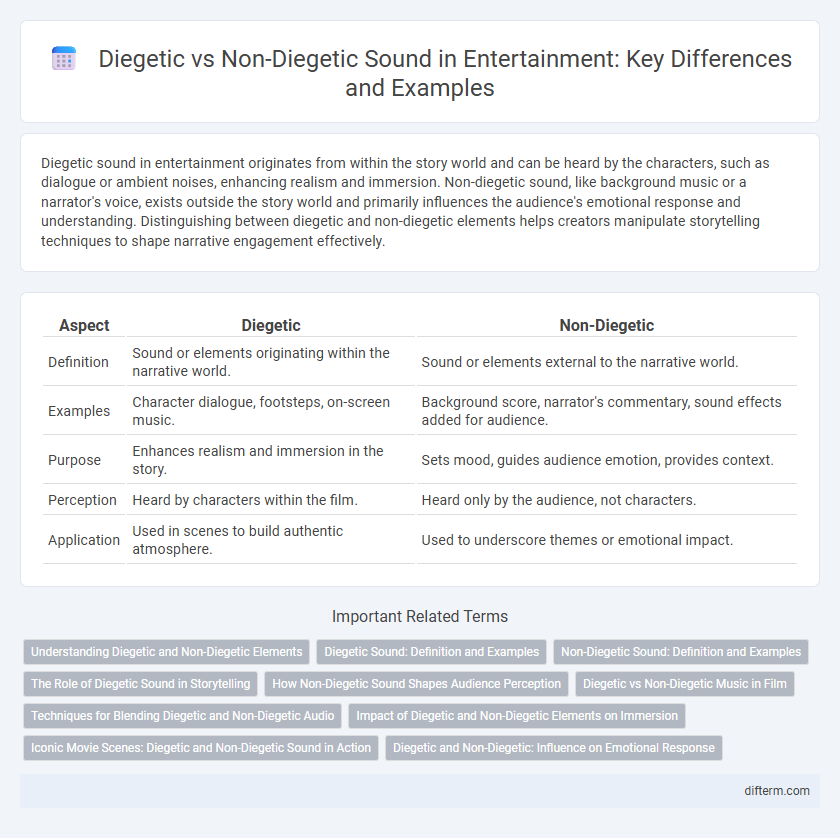Diegetic sound in entertainment originates from within the story world and can be heard by the characters, such as dialogue or ambient noises, enhancing realism and immersion. Non-diegetic sound, like background music or a narrator's voice, exists outside the story world and primarily influences the audience's emotional response and understanding. Distinguishing between diegetic and non-diegetic elements helps creators manipulate storytelling techniques to shape narrative engagement effectively.
Table of Comparison
| Aspect | Diegetic | Non-Diegetic |
|---|---|---|
| Definition | Sound or elements originating within the narrative world. | Sound or elements external to the narrative world. |
| Examples | Character dialogue, footsteps, on-screen music. | Background score, narrator's commentary, sound effects added for audience. |
| Purpose | Enhances realism and immersion in the story. | Sets mood, guides audience emotion, provides context. |
| Perception | Heard by characters within the film. | Heard only by the audience, not characters. |
| Application | Used in scenes to build authentic atmosphere. | Used to underscore themes or emotional impact. |
Understanding Diegetic and Non-Diegetic Elements
Diegetic elements in entertainment refer to sounds, music, and events that originate within the story world, such as characters speaking or music playing from a radio on screen. Non-diegetic elements are those external to the narrative, including background scores, voice-over narrations, and sound effects added to enhance mood or tension without affecting the story's reality. Understanding the distinction between diegetic and non-diegetic elements is crucial for analyzing how filmmakers and creators manipulate audience perception and emotional response.
Diegetic Sound: Definition and Examples
Diegetic sound refers to audio elements originating from a source within the film's world, such as characters talking, footsteps, or a radio playing music that the characters can hear. This type of sound enhances realism by grounding the audience in the narrative environment and contributing to storytelling through natural auditory cues. Notable examples include dialogue between characters, ambient noises like rain or traffic, and music from in-scene objects like jukeboxes or instruments.
Non-Diegetic Sound: Definition and Examples
Non-diegetic sound refers to audio elements in entertainment that originate outside the story world, such as background music, narration, or sound effects not heard by characters. Examples include orchestral scores enhancing emotional impact in films like "Jaws" and voice-over narration in documentaries or animations. These sounds guide audience perception and mood without influencing the diegesis experienced by the characters.
The Role of Diegetic Sound in Storytelling
Diegetic sound in entertainment, such as character dialogue, footsteps, and environmental noises, creates an immersive experience by anchoring the audience within the story's world. It enhances narrative realism and emotional depth, allowing viewers to connect with on-screen events and characters more authentically. This sound type contrasts with non-diegetic sound, like background scores, which guide audience perception without existing within the story's reality.
How Non-Diegetic Sound Shapes Audience Perception
Non-diegetic sound, such as background music or voiceovers, profoundly influences audience perception by guiding emotional responses and highlighting narrative themes without existing within the story world. Film scores often manipulate tension, mood, and atmosphere, shaping viewers' understanding of characters and plot developments indirectly. This auditory layer enhances storytelling by creating immersive experiences that transcend the visual elements alone.
Diegetic vs Non-Diegetic Music in Film
Diegetic music in film originates within the story's world, such as characters playing an instrument or a radio playing, enhancing realism and audience immersion. Non-diegetic music, often known as the film score or soundtrack, is added externally to influence emotions, set the mood, or foreshadow events without the characters' awareness. Understanding the distinction between diegetic and non-diegetic music is essential for analyzing film narrative techniques and audience engagement.
Techniques for Blending Diegetic and Non-Diegetic Audio
Techniques for blending diegetic and non-diegetic audio include strategic sound design that seamlessly integrates on-screen sounds with background scores, enhancing narrative immersion without disorienting viewers. Audio transitions often employ gradual fades, overlapping motifs, or spatial audio cues to bridge the gap between characters' environments and the film's emotional tone. Effective use of these techniques deepens audience engagement by subtly aligning diegetic sounds with non-diegetic music or effects, creating a cohesive auditory experience in cinematic storytelling.
Impact of Diegetic and Non-Diegetic Elements on Immersion
Diegetic elements, such as character dialogue and on-screen sounds, anchor viewers within the film's realistic world, enhancing immersion by maintaining narrative coherence. Non-diegetic components like background scores and voice-over narration shape emotional responses and guide audience interpretation without existing in the story's reality. The interplay between diegetic and non-diegetic elements creates a balanced sensory experience that deepens engagement and influences viewer perception of the narrative.
Iconic Movie Scenes: Diegetic and Non-Diegetic Sound in Action
Iconic movie scenes often leverage diegetic sound, such as a character's footsteps or dialogue, to ground the audience in the film's reality, enhancing immersion and emotional connection. Non-diegetic sound, including background scores and dramatic music, amplifies tension and guides viewer emotions without originating from the scene's environment. The interplay between diegetic and non-diegetic sound in action sequences intensifies the cinematic experience by balancing realism with heightened dramatic effect.
Diegetic and Non-Diegetic: Influence on Emotional Response
Diegetic music, originating within the story world, enhances emotional connection by immersing viewers in characters' experiences, while non-diegetic music, external to the narrative, manipulates audience emotions through mood-setting scores. The interplay between diegetic and non-diegetic elements shapes tension, empathy, and narrative pacing, driving deeper engagement with the visual content. Studies in film theory demonstrate that strategically blending these sound types significantly affects viewers' psychological and emotional responses.
diegetic vs non-diegetic Infographic

 difterm.com
difterm.com